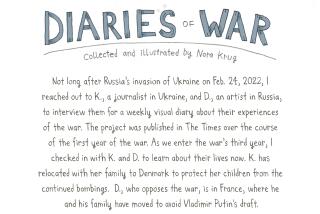‘Memories of the Future’ by Sigizmund Krzhizhanovsky
Memories of the Future
Sigizmund Krzhizhanovsky
Translated from the Russian
by Joanne Turnbull
New York Review Books Classics: 256 pp., $15.95 paper
There was probably no worse time and place to be a postmodernist sage than in 1920s Russia. Still, bibliophiles like to believe that genius makes itself known, regardless of social pressures, and in the case of Ukraine-born Sigizmund Krzhizhanovsky, they may have a point -- only it took about six decades for anyone else to catch on.
Krzhizhanovsky wrote the seven mad -- albeit, magisterially controlled -- stories of “Memories of the Future” in Moscow between 1925 and 1930. To say they were suppressed is to suggest they were given much of a chance at all; rather, six of these crypto-gems were essentially binned until 1989, when they finally escaped the vast hold of the Soviet Central State Archives, with another story discovered quite by accident in Kiev in 2005. It’s not that Krzhizhanovsky’s tales espouse a violent political radicalism or even the kind of art-house writing that went against the nationalist creations preferred by the Bolsheviks. Instead, what one immediately denotes in most of these pieces is a stately, demurring sadness, nostalgia crossed with brave, futurist dreams and the dual threat/relief of the cemetery plot.
These were discomfiting notions in a Russia that was in the practice of trading in happier maxims. Conversely, Krzhizhanovsky’s characters spend a lot of time walking through grave sites, ruminating, chatting, networking, clapping each other on the back over the latest, wistful gallows joke. It’s as though they all worked together to dislocate traditional meanings from traditional concepts of place, fostering new worlds in the process, which probably wasn’t a bad idea if you were a master prose stylist who couldn’t get anyone to run your work and you wanted a new way of looking at the world.
Despite his limited publishing options, Krzhizhanovsky came to embrace Moscow with the same zeal that Chekhov had for the steppe and the peasant fire, and the settings themselves become characters in his fictions. “The Bookmark” begins by apostrophizing the titular noun: This particular bookmark, it seems, has lacked a good book in which to be burrowed. In search of a solution, its owner heads out on a walk, wondering what book he might offer his place-holding friend, and encounters a failed writer whom he bills as the “theme catcher.” Catching sight of a mangy cat or a blowing fragment of birch bark, he eases into improvised narrative: The tom meets a tragic end, the fragment changes a political career, as observation gives life to full stories. All the while, the sights and sounds of Moscow drive the direction of the narrative, an evocation of the metropolis as its own living, organic, intensely human creation.
For all the cemetery meanderings -- and they’re key to “The Bookmark” -- Krzhizhanovsky is also hilarious, and one wonders whether that might have troubled the Bolsheviks as much as anything in his work. Krzhizhanovsky understood the potency of juxtaposing wit with terror and the sacred with the profane. He’s what one might call a “life writer” -- stories such as “Red Snow” and “Memories of the Future” teem with it, the human essence in all its contradictions and permutations, a big spongy mass. Formal precision is a hallmark of these pieces, but you’ll not encounter anything arch or, as we might say today, uptight, in a Krzhizhanovsky story. It’s a treat to hang out with Max Shterer from “Future.” Put off by H.G. Wells’ “The Time Machine,” Max decides to have a go himself with the whole time-space manipulation business. Not only does he invent a device to rend time -- behold, the “timecutter” -- but he also hits upon the idea of selling a book of his travels through the temporal continuum. A real-life nonfiction book -- an interesting goal for a sci-fi hero fond of making metaphors about the Soviet political state. A publisher is less than thrilled:
“Facts, facts! Who’s seen them, these facts of yours? Where, I ask you, is the witness who will come forward and corroborate them?
“He’s coming. Or don’t you hear him? I mean the actual future.”
Never mind what this being/fellow looks like or how he sounds -- it’s a good bit of musical language, an ominous, open-ended chord that refuses to resolve and simply rings on.
“The Branch Line” and “Thirteenth Category of Reason” are more opaque. There’s less outright mirth, and their truths are oblique, whispers couched in whispers. As a passing stranger remarks in “The Branch Line”: “Understanding is strictly forbidden. Even dreams have the right to dream. Isn’t that so? Now go away.”
The opening story, “Quadraturin,” is its own hell-born, absurdist dream -- a dream come to life in an 86-foot-square room that grows, maw-like, with the application of a magic, experimental paste. Sutulin, the room’s tenant, is eventually swallowed whole by his home, or is at least lost within it. As his four squat walls continue to expand, Sutulin’s own external existence diminishes. He meets a former lover on the street and resists her advances. “My place . . . isn’t fit,” he tells her. The bulging room that bulges only on its inside -- a Doctor Who-type trick -- now mirrors a priapic issue, all of which is a metaphor for the futility of Bolshevik-sanctioned “art.” Not exactly shocking, then, that Krzhizhanovsky couldn’t get a publisher in Stalinist Russia. Good thing the future eventually bailed out the past on this one.
Fleming is a critic who writes for publications including Rolling Stone and The New Yorker. He is completing a short story collection, “Friends Are Ends,” and a novel.
More to Read
The biggest entertainment stories
Get our big stories about Hollywood, film, television, music, arts, culture and more right in your inbox as soon as they publish.
You may occasionally receive promotional content from the Los Angeles Times.






